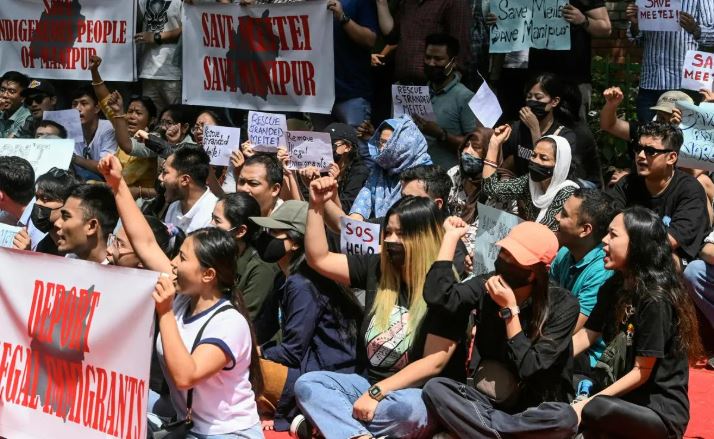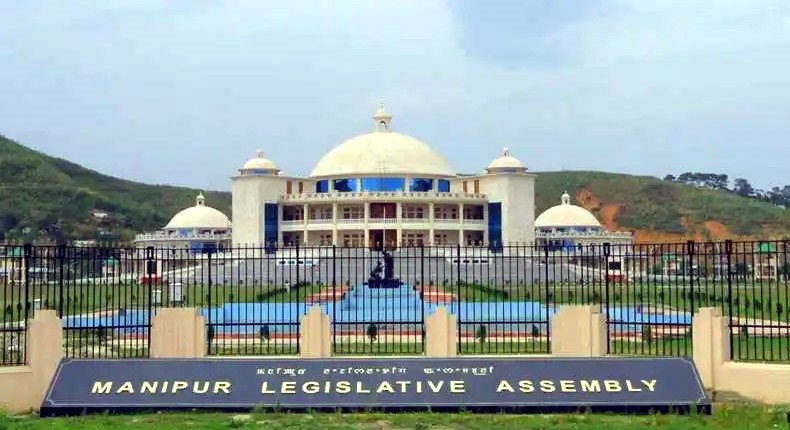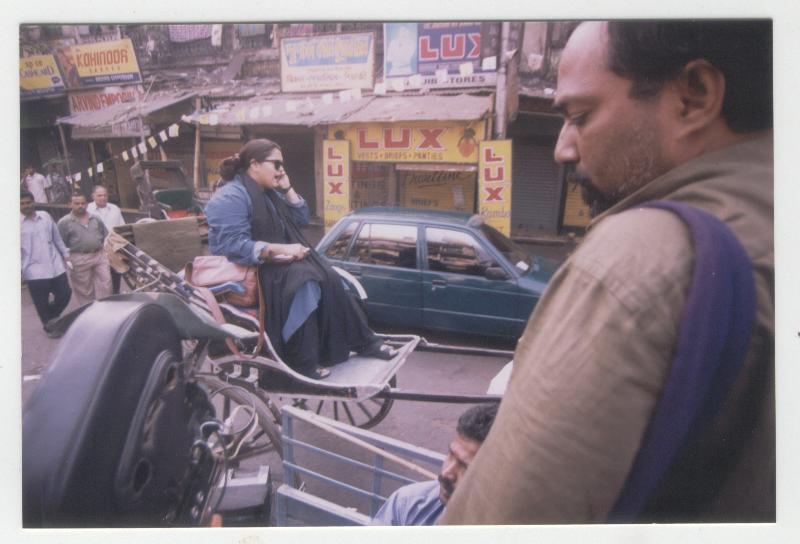- About the Manipur Hill Areas (Acquisition of Chiefs’ Rights) Act, 1967:
- “The Manipur Hill Areas (Acquisition of Chiefs’ Rights) Act, 1967 (Manipur Act No. 5 of 1967)” obtained the assent of the President of India on 14th June 1967 and it was published in the Manipur Gazette (Extraordinary) No. 61-E-50 dated 20 June 1967.
- The Bill corresponding to the said Act viz., The Manipur Hill Areas (Acquisition of Chiefs’ Rights) Bill, 1967 (Bill No. 2 of 1967) was introduced to the Manipur Legislative Assembly on 7th September 1966 after obtaining recommendation from Shri Baleshwar Prasad, then Chief Commissioner, Manipur. The bill was passed on 10th January 1967 after taking approval from the Manipur Assembly Standing Committee and after hectic deliberation on the floor of the Assembly.
- The Chief Commissioner reserved the passed Bill for consideration of the President of India as required under section 25 of the Government of Union Territories Act, 1963 and recommended the same on 28th February 1967 to the Secretary, Government of India, Ministry of Home Affairs for obtaining the assent of the President. After having consultation and clearance from the Planning Commission, the Ministry of Law and the Ministry of Food, Agriculture, Community Development and Cooperation (Department of Agriculture), Shri Vidya Charan Shukla, then Home Minister, Government of India recommended the Bill on 12th June 1967 to the President for his assent. The President assented to the Bill on 14th June 1967. Thereafter, on the next day i.e., 15th June 1967, the Ministry of Home affairs returned two authenticated copies of the Bill with the President’s assent signified thereon to the Chief Commissioner, Manipur. The Secretariat-Law Department, Government of Manipur notified the “The Manipur Hill Areas (Acquisition of Chiefs’ Rights) Act, 1967” on 20th June 1967 and published the same in the Manipur Gazette (Extraordinary) No. 61-E-50 on the same day of 20th June 1967.
- By a telegram dated 29th September 1967, the Ministry of Home Affairs intimated the Government of Manipur to send 10 copies of the Manipur Hill Areas (Acquisition of Chiefs’ Rights) Act, 1967 immediately and the Government of Manipur complied with the Ministry’s instructions by sending 10 copies of the said Act by post on 30th September 1967. The Ministry received those copies of the Act on 8th October 1967.
- Following the resignation of the Speaker of the Manipur Legislative Assembly, President Rule (Animated Suspension) was imposed in Manipur during 25th October 1967 to 18th February 1968 (116 days). Immediately after PR was imposed, about 300 Kuki chiefs stage-managed a grand show of protest against the Manipur Hill Areas (Acquisition of Chiefs’ Rights) Act, 1967 and the Government of Manipur seized all copies of the Act. Since then, no copies of the said Act were available in the administrative departments/sections of the Government of Manipur. Notably, T. Kipgen hailing from Kuki community was the Home Secretary of the Government of Manipur at that point of time.
- The existence of the Manipur Hill Areas (Acquisition of Chiefs’ Rights) Act, 1967 came into light very recently when the file containing the entire procedure from introduction of the corresponding Bill in the Manipur Legislative Assembly to publication of the Act in the Manipur Gazette was made available in the National Archive of India.
- Manipur was upgraded from the status of Union Territory to a full-fledged State of India by the North-Eastern Areas (Reorganisation) Act, 1971 (Act No. 81 of 1971) with effect from 21st January 1972. In exercise of the powers conferred by section 79 of the North-Eastern Areas (Reorganisation) Act, 1971, the Government of Manipur made the Manipur (Adaptation of Laws) Order, 1972 and notified the same in the Manipur Gazette on 21st January 1972 for facilitating the application of several laws including the Manipur Hill Areas (Acquisition of Chiefs’ Rights) Act, 1967 to the State of Manipur with effect from 21st January 1972.
- As per sub-section 3 of section 1 of “The Manipur Hill Areas (Acquisition of Chiefs’ Rights) Act, 1967”, the Act has been in force right from 20th June 1967 i.e., the date of notification of the Act in the Manipur Gazette. Further, in view the Manipur (Adaptation of Laws) Order, 1972, the Manipur Hill Areas (Acquisition of Chiefs’ Rights) Act, 1967 remains in force still today.
- Objectives of the said Act of 1967
The Manipur Hill Areas (Acquisition of Chiefs’ Rights) Act, 1967 has two main objectives viz., (i) Abolition of Hereditary Chieftainship, and (ii) Establishment of uniform land laws throughout the territory of Manipur.
- Abolition of Hereditary Chieftainship
The Manipur Hill Areas (Acquisition of Chiefs’ Rights) Act, 1967 was enacted essentially to abolish the institution of hereditary Chieftainship where the chiefship of village is hereditary passing down from father to a son usually the youngest or the eldest. Other sons of the chief often venture out to set up their own villages each consisting of a minimum of 20 houses. A daughter has no right for inheritance. This Act of 1967 vest in the Government of Manipur all the rights, titles, and interests of hereditary chiefs in the village lands on payment of compensation. It does not affect other forms of village chiefships where the chiefs are elected or appointed by the villagers.
Hereditary chieftainship is prevalent among the Kuki-Zo tribes. The village system among the Kuki-Zo tribes is best described as a series of petty states, each under a Dictator or chief (Called Lal). A hereditary chief has supreme authority with executive, judicial and military power. He claims the absolute ownership of the village under his jurisdiction and the land including forests within the village. He is the commander-in-chief of the village army. In times of war, the chief is supposed to lead the army. The chief is the guardian of law, and his words are laws. His power is absolute and his decision in any dispute is final. The chief is assisted by ‘Upas’ who are the elders of the village, appointed by him as advisors. However, he is not bound to abide by the advice of the Upas and has the last word in any matter. The decision of the Upas without consulting the chief cannot be taken as final. ‘Haosa’ is the office of the village chief. The chief is the Lord of the soil. A chief can allot village land to outsiders, including foreigners, and make them settle in the village as long as they please him. Villagers have no freedom, and they live in the village at the pleasure of the chief. All villagers owe allegiance to the chief with respect and pay such taxes as imposed by the chief. The chief can appoint and dismiss or expel anyone in the village. The villagers do not have the right to oppose their chief individually as well as collectively.
The Manipur Hill Areas (Acquisition of Chiefs’ Rights) Act, 1967 will not affect the Nagas and Old Kuki tribes (viz. Kom, Chiru, Koireng, Lamgang, Anal, Chothe, Purum, Aimol) as their Chieftainship is not hereditary unlike that of the Kuki-Zo tribes. The Naga Chiefs and the Old Kuki chiefs are elected by the villagers, and they do not claim ownership of the village and forest. Their role is mainly limited to ceremonial and religious activities. They do not have supreme authority and power like the hereditary chieftains. The advice of the village elders and the council binds them.
The institution of hereditary chieftainship is anti-ethical to the practice of democracy. There is sufficient room for a Kuki-Zo chief to become tyrannical. The institution of hereditary chieftainship was abolished in the Chin Hills of Burma (Myanmar) in February 1948. In Mizoram, the system of hereditary Chieftainship was abolished by the Assam-Lushai District (Acquisition of Chiefs’ Rights) Act, 1954. In Tripura, the Panchayat System has replaced the institution of Kuki Chieftainship, which functions under the Tripura Tribal Areas Autonomous District Council.
Although Manipur Hill Areas (Acquisition of Chiefs’ Rights) Act, 1967 was notified and published on 20th June 1967, it has not been in force yet due to objections from the frantic lobby of the politically powerful Kuki-Zo chiefs. Due to non-enforcement of the said Act of 1967, the institution of hereditary chieftainship still survives and is currently in practice among the Kuki-Zo tribes inhabited in Manipur. Presently, Manipur is the only State in the Northeast where the hereditary Chieftainship exists.
- Establishment of uniform land laws throughout the territory of Manipur:
Section 19 of the Manipur Hill Areas (Acquisition of Chiefs’ Rights) Act, 1967 extends the Manipur Land Revenue and Land Reforms (MLR & RL) Act, 1960 to the Hill Areas of Manipur subject to the amendments/modifications specified in the Schedule to the Act of 1967.
The amendments/modifications made in MLR & RL Act, 1960 by the Schedule to section 19 of the Manipur Hill Areas (Acquisition of Chiefs’ Rights) Act, 1967 w.e.f. 20th June 1967 are as under:
| Relevant section of the MLR & RL Act | Un-amended statement | Amended statement |
| Sub-section (2) of section 1 | “(2) It extends to the whole of the Union territory of Manipur except the hill areas thereof.” | “(2) It extends to the whole of the Union territory of Manipur; Provided that in respect of the Hill Areas, only the provisions of Part I and II shall apply.” |
| Sub-section (3) of section 1 | “(3) It shall come into force on such date as the Administrator may, by notification in the Official Gazette, appoint; and different dates may be appointed for different areas and for different provisions of this Act.” | “(3) It shall come into force on such date as the Administrator may, by notification in the Official Gazette, appoint; and different dates may be appointed for different areas and for different provisions of this Act; Provided that in respect of the Hill Areas or any part thereof all the provisions of parts I and II of this Act shall come into force on the date specified therefor in the notification issued under section 19 of the Manipur Hill Areas (Acquisition of Chiefs’ Rights) Act, 1967.” |
| Clause (d) of section 2 | “(d) “commencement of this Act”, in relation to any provision, means the date specified in respect
of that provision in a notification under sub-section (3) of section 1;” |
“(d) “commencement of this Act”, in relation to any provision, means the date specified in respect
of that provision in a notification under sub-section (3) of section 1; Provided that in respect of the Hill areas or any part thereof it shall mean the date specified in respect of that area in the notification issued under section 19 of the Manipur Hill Areas (Acquisition of Chiefs’ Rights) Act, 1967. ” |
| Clause (j) of section 2 | “(j) “hill areas” means such areas in the hill tracts of the Union territory of Manipur as the Administrator may, by notification in the Official Gazette, declare to be hill areas;” | “(j) “hill areas” means the areas in the hill tracts of the Union territory of Manipur as have been declared to be hill areas by the Administrator by notification in the Official Gazette before the commencement of the Manipur Hill Areas (Acquisition of Chiefs’ Rights) Act, 1967.” |
| Sub-section (1) of section 12 | “(1) The right to all trees, jungles or other natural products growing on land set apart for forest reserves and to all trees, brush wood, jungle or other natural product, wherever growing, except in so far as the same may be the property of any person, vests in the Government, and such trees, brush wood, jungle or other natural product shall be preserved or disposed of in such manner as may be prescribed, keeping in view the interests of the people in the area with regard to the user of the natural products.” | “(1) The right to all trees, jungles or other natural products growing on land set apart for forest reserves and to all trees, brush wood, jungle or other natural product, wherever growing, except in so far as the same may be the property of any person, vests in the Government, and such trees, brush wood, jungle or other natural product shall be preserved or disposed of in such manner as may be prescribed, keeping in view the interests of the people in the area with regard to the user of the natural products. Provided that the residents of the Hill Areas shall, subject to such conditions as may be prescribed, be allowed to take so much timber, fire wood or other natural products belonging to the Government for their domestic or agricultural purpose from any place within the Hill Areas, not being a reserved forest, as may be notified by the Government from time to time.” |
| Sub-section (1) of section 14 | “(1) The deputy commissioner may allot land belonging to the Government for agricultural purposes or for construction of dwelling houses, in accordance with such rules as may be made in this behalf under this Act; and such rules may provide for allotment of land to persons evicted under section 15. “
|
“(1) The deputy commissioner may, subject to the provisions contained in section 18 of the Manipur Hill Areas (Acquisition of Chiefs’ Rights) Act, 1967, and the rules made under the Act allot land belonging to the Government for agricultural purposes or for construction of dwelling houses, in accordance with such rules as may be made in this behalf under this Act; and such rules may provide for allotment of land to persons evicted under section 15.” |
| Clause (b) of sub-section (2) of section 14 | “(b) to entrust the management of any such land or any rights therein to the Gram Panchayat of the village established under any law for the time being in force.” | “(b) to entrust the management of any such land or any rights therein to the Gram Panchayat or any other local authority of the village established under any law for the time being in force.” |
| Clause (iii) of sub-section (2) of section 98 (A new clause) | “(iii) the conditions under which the residents of Hill Areas may be allowed to take timber, fire wood and other natural products for domestic use or agricultural purposes from any place in the Hill Areas, not being a reserved forest.” |
Notably, clause 1(a) of the Schedule under section 19 of The Manipur Hill Areas (Acquisition of Chiefs’ Rights) Act, 1967 has deleted the phrase “except the hill areas thereof” provided in section 1(2) of the Manipur Land Revenue and Land Reforms (MLR & RL) Act, 1960 and made parts I and II of the MLR & RL Act applicable to the “Hill Areas” defined thereto.
More notably, clause 2(c) of the Schedule under section 19 of The Manipur Hill Areas (Acquisition of Chiefs’ Rights) Act, 1967 has changed the definition of “Hill Areas” provided in clause (j) of section 2 of the MLR & RL Act, 1960 as under:
“(j) “hill areas” means the areas in the hill tracts of the Union territory of Manipur as have been declared to be hill areas by the Administrator by notification in the Official Gazette before the commencement of the Manipur Hill Areas (Acquisition of Chiefs’ Rights) Act, 1967.”
The relevant order mentioned in the amended clause (j) of section 2 of the MLR & RL Act, 1960 is the Government of Manipur notification No. 19/3/62/Pol dated 10.5.1963 published in the Manipur Gazette on 15th May 1963 according to which the whole territory of Manipur is divided into two areas namely, “Valley Areas” and “Hill Areas” comprising of the following Revenue Sub-Divisions:
| Name of Area
|
Revenue Sub-Divisions | |
| (i) | Valley Areas | (1) Imphal West, (2) Imphal East, (3) Thoubal, (4) Bishenpur, (5) Churachandpur, (6) Jiribam, (7) Tengnoupal and (8) Sadar Hills Development Block in Mao-Sadar Sub-Division |
| (ii) | Hill Areas | (1) Tamenglong, (2) Ukhrul and (3) Mao-Sadar Sub-Division excluding Sadar Hills Development Block |
Since both the Manipur Hill Areas (Acquisition of Chiefs Rights) Act, 1967 and the Manipur Land Revenue and Land Reforms (MLR & RL) Act, 1960 as have been made applicable to the State of Manipur w.e.f. 21st January 1972 by the Manipur (Adaptation of Laws) Order, 1972 the definitions of “Valley Areas” and “Hill Areas”, provided in the amended clause (j) of section 2 of the MLR & RL Act, 1960 still hold today.
- ADVERSE EFFECTS FOR NON-IMPLEMENTATION OF THE ACT OF 1967
- Abnormal increase of villages in Kuki-Zo dominated areas of Manipur
By comparing the number of villages of the districts of Manipur for the year 1969 and 2023 (see Table 1), it is noticed that there has occurred abnormal increase of villages in Kuki-Zo dominated hill areas of Manipur.
Table 1: District-wise growth of villages in Manipur during 1969-2023
| Districts | No. of villages in 1969 as published in Gazette | No. of villages in 2023 as provided by Ministry of Pachayati Raj, GoI | Increase (+)/
Decrease (-) |
| Imphal West | 181 | 201 | + 20 |
| Imphal East | 187 | 232 | + 45 |
| Thoubal (plus Kaching) | 149 | 194 | + 45 |
| Bishnupur | 70 | 111 | + 41 |
| Jiribam | 102 | 79 | – 23 |
| Chandel | 164 | 460 | + 296 |
| Tengnoupal | 68 | 326 | +258 |
| Tamenglong | 116 | 146 | + 30 |
| Noney (Nungba) | 62 | 73 | + 11 |
| Kangpokpi | 179 | 721 | + 542 |
| Senapati | 126 | 147 | + 21 |
| Churachandpur | 282 | 842 | + 560 |
| Pherzwal | 38 | 100 | + 62 |
| Ukhrul | 106 | 92 | – 14 |
| Kamjong | 127 | 132 | + 5 |
| TOTAL | 1957 | 3856 | +1899 |
From the numerical figures shown in Table 1, it is crystal clear that there is abnormal increase of villages in the Kuki-Zo dominated districts namely, Churachandpur, Kangpokpi, Tengnoupal, Chandel and Pherzwal. This abnormal growth of villages in these districts indicates that a huge number of Kuki-Zo refugees/illegal migrants from Myanmar, Bangladesh and other neighbouring States have entered into Manipur in the last few decades and taken settlement in those villages under the patronage of hereditary chiefs. According to the land ownership system prevalent among the Kuki-Zo tribes, only one son can inherit the chiefship of a village from his father. Other sons of the chief often venture out to set up their own villages. The Manipur (Village Authorities in Hill Areas) Act, 1956 requires a minimum of 20 houses to establish a new village. The ambitious sons of a Chief who have the desire of becoming village chiefs can fulfil their aspiration by establishing new villages with assimilation of Kuki-Zo refugees/illegal migrants as members of the villages. The chief can allot land to outsiders, including foreigners, and make them settle in the village as long as they please him. This wrong social practice leads to rapid growth of new villages in the Kuki-Zo dominated districts.
Table1 also brings the fact to the fore that there is normal growth of villages, attributable to increase of population by births, in respect of Meitei dominated districts: all the districts of the central valley of Manipur namely, Imphal West, Imphal East, Thoubal (including Kakching) which are dominated by the Meiteis have normal growth. But in case of Jiribam district which is also a Meitei dominated district, there is sharp decrease in the number of villages during the period 1969 to 2023. The decrease in the number of villages in respect of Jiribam district is due to transfer of 15 villages in 1969 and 14 villages in 1972 from Jiribam to Churachandpur. Way back in January 1953, 42 villages were transferred from Thoubal to Churachandpur. The pattern of growth of villages in Naga dominated districts namely, Tamenglong, Noney, Senapati, Ukhrul and Kamjong may also be taken as normal. The decrease in the number of villages in respect of Ukhrul district is due to creation of Kamjong district out of Ukhrul district in 2016.
- Raise of the Kuki-Zos and Fall of the Meiteis in Manipur
The introduction of Free Movement Regime (FMR) in 1950, the abolition of Permit System in 1950 and the introduction of Scheduled Tribes list in Manipur in 1951 did pave fertile grounds for influx of Kuki-Zo tribes into Manipur from Burma (now Myanmar), East Pakistan (now Bangladesh) and neighbouring States for taking settlement in the hill areas of Manipur under the patronage of hereditary Chiefs. Notably, Manipur has 398 km long porous border with Myanmar. Vide their Notification No. 4/15/50-F.I., dated 26.9.1950 the Ministry of Home Affairs, Government of India introduced “The Free Movement Regime (FMR)” whereby the “hill tribes, who is either a citizen of India or the Union of Burma and who is ordinarily a resident in any area within 40 km (25 miles) on either side of the India-Burma frontier” were exempted from the carrying of passport or visa while entering into India. “The Permit System for entry into and exit from Manipur” which was introduced in 1901 and further retained by the Government of India vide letter No. 120/47/C-26-27 dated 17.1.1948 issued by the Office of the Advisor for Excluded Areas & State, Shillong was abolished by Himmat Singh, the then Chief Commissioner, Manipur on 18th November, 1950 vide Notification No. 8597-601 H.D. dated 18.11.1950. The Ministry of Law, Government of India, vide their notification No. S.R.O. 1427-B dated 20.9.1951, notified the first Scheduled Tribes list of Manipur comprising of three generic tribe names viz. (i) Any Kuki tribe, (ii) Any Lushai tribe and (iii) Any Naga tribe. The sequence of changes in administrative rules that were introduced swiftly after Manipur’s merger into India on 15th October 1949 could be a design for facilitating easy entry of Kuki-Zos into Manipur from Burma (now Myanmar) and Lushai Hills (now Mizoram) meticulously worked out by Thangkhopao Kipgen (T. Kipgen), the then Assistant Secretary (Home & Development) to the Government of Manipur. T. Kipgen was a Kuki nationalist who had strong desire to establish a “larger Kuki-Chin/Kuki-Zo confederation”. He founded in 1946 both the Kuki Inpi, Manipur (KIM) as its founding President and the Kuki National Assembly as its founding Secretary. T. Kipgen was instrumental for ceding Manipur into India in October, 1949. Vide Manipur Government Order No. 40 of 1950 dated 21.1.1950 under File No. A-I-3560-6, the Government Secretariat was divided into four departments viz., Revenue Department, Finance Department, Home Department and Development Department and T. Kipgen was appointed as Assistant Secretary (Home and Development). Vide Manipur Government Order No. 50 of 1950 dated 24.1.1950 under File No. A-I-3623-36, T. Kipgen was additionally given the charge of Deputy Collector investing with him the power of Magistrate of the First Class.
- Kipgen remained as the de-facto administrator of the hill areas of Manipur for 22 years (1950-1972). He was the first IAS officer (1953 batch) and he left Manipur in 1972 to join as the Chief Secretary of Goa which he held until his retirement in 1978. He played key roles behind the enactment of various laws for providing Special Provisions for the hill areas of Manipur namely, “The Manipur (Village Authorities in Hill Areas) Act, 1956”, “The Manipur Land Revenue and Land Reforms Act, 1960”, “Section 52 (Special provisions for Hill Areas of Manipur) in the Government Union Territories Act, 1963”, “The Manipur (Hill Areas) District Councils Act, 1971”, “Article 371C of the Constitution of India”, “The Manipur Legislative Assembly (Hill Areas) Order, 1972”, among others. Because of the presence so many laws for providing Special Provisions for the hill areas of Manipur, this tiny State of Manipur which is just 22,327 sq. km. in area is wrongly divided into two regions namely, (i) “Hill areas” with 92% of total area exclusively inhabited by Kuki-Zo (currently about 70%) and Naga tribes (currently about 22%) and (ii) “Valley areas” with 8% of total area inhabited by all communities irrespective of castes, creed, race and religion which include the Meiteis, the Muslims, the Nepalis, Kuki-Zo tribes, Naga tribes, the Bengalis, the Punjabis, Jains, among others.
The tag of ‘Scheduled Tribe’ is being used as a powerful means for giving Indian Citizenship to the Kuki-Zo refugees/illegal migrants sneaking into Manipur just like ‘Visa on Arrival under the patronage of hereditary Chiefs. It is an established fact that thousands of Chin-Kuki-Zo refugees/ illegal migrants have taken settlements silently and illegally in many reserved forest lands in the hill areas of Manipur indulging in various kinds of subversive activities including the so-called notorious narco-terrorism. Taking supports from these refugees/illegal migrants, the Kuki-Zos of Manipur have now claimed that they have hegemonically occupied more than 70% of the total geographical area of the State of Manipur including the hill areas surrounding the central valley and have even started demanding a separate homeland of the Kuki-Zos by dismembering Manipur. They have been ceaselessly attempting with all-out efforts to realize the long-cherished dream of a larger Kuki-Mizo-Chin confederation called ‘ZALENGAM’ to be formed dissecting from the territories of India, Myanmar and Bangladesh.
Notably, the Scheduled Tribes of Manipur including the Kuki-Zo tribes are annually entitled to receive financial assistance in terms of several crores of Rupees from the Ministry of Tribal Affairs, Government of India under various welfare schemes of the Ministry apart from enjoying reservation in posts/services and exemption from paying income tax, among others. For instance, the details of fund released by the Ministry of Tribal Affairs, Government of India exclusively for the Scheduled Tribes of Manipur for the financial years 2017-18, 2018-19, 2019-20 which constituted more than one-third of the total central fund released to the Government of Manipur for each financial year, are as under:
| Financial Year | Fund Released to the Govt. of Manipur from Ministry of Tribal Affairs | Total Fund released to the Govt. of Manipur from various Ministries of the Govt. of India | Share of Fund from the Ministry of Tribal Affairs to the Total Central Fund |
| 2017-18 | Rs. 133,64.32 lacs | Rs. 404,45.86 lacs | 33.04% |
| 2018-19 | Rs. 153,87.55 lacs | Rs. 369,28.49 lacs | 41.67% |
| 2019-20 | Rs. 151,41.82 lacs | Rs. 425,01.23 lacs | 35.63% |
On the other hand, for want of safeguards and protections under the Constitution of India, the overall socio-economic and living conditions of the Meiteis have been rapidly deteriorating thereby compelling them to face various challenges such as:
- Rapid decline of land holdings of the Meiteis in Manipur: Existing land laws which are in force in Manipur have segregated the Meiteis to take settlement only in the central valley which constitutes merely 8% of the geographical area of Manipur. Since many poverty-stricken Meiteis have been selling their lands to people of other communities, the share of land holdings of the Meiteis in Manipur is continuously shrinking. It is estimated that currently, the share of land holdings of the Meiteis in Manipur is about 4% of the geographical area of Manipur.
- Rapid decline of the Meiteis’ population in Manipur: The share of the Meiteis’ population to the total population of Manipur has decreased from 56.2% in 1881 to 44.9% in 2011 with annual growth rate of 7.17%. On the other hand, the share of the Muslims’ population to the total population of Manipur has increased from 2.2% in 1881 to 8.4% in 2011 with annual growth rate of 37.03% which is more than the population growth rate of the Meiteis.
- Lowest birth rate of the Meiteis in Manipur: As per the Report of 5th National Family Health Survey (2019-20), Meitei women have the lowest “Total Fertility Rate” (TFR) value of 1.77 which is the lowest among all communities living in Manipur. Since this value of TFR is much lower than the minimum critical value (2.11) required for sustainable survivance, it may be speculated that days are not far away for the Meiteis to become a minority community in Manipur.
- Deplorable economic conditions of the Meiteis in Manipur: Agriculturalist Meiteis cannot produce agricultural yields sufficiently to meet their financial needs. The traditional cottage market is dwindling day by day. Machines have substituted many traditional looms driving out many Meiteis from their self-employment. The products of big business enterprises from outside the state have gradually taken over the market of cottage industry products. Thousands of employable Meiteis remain without gainful employment. There is no major industry in Manipur where they can be employed. In terms of the Monthly Per Capita Consumption Expenditure (MPCE) which measures the standard of living, the Meiteis have lower MPCE than the Scheduled Tribes in both Rural and Urban areas of Manipur. For instance, for the financial year 2011-12, MPCE for STs, SCs, and OBCs were Rs. 1526.00, Rs. 1251.00, Rs. 1523.00 respectively in the rural areas of Manipur and Rs. 1748.00, Rs. 1506.00 and Rs. 1455.00 respectively in the urban areas of Manipur.
- Insecurity being faced by the Meiteis in Manipur: The central valley of Manipur is the traditional home of the Meiteis. The central valley is surrounded in all directions by rows of hills inhabited by Kuki-Zo tribes. The Meiteis living in the central valley of Manipur is currently facing insecurity and the fear of being attacked by the Kuki-Zo militants. The current conflict in Manipur has led to the creation of a “Buffer Zone” which have restricted the movement of the Meiteis only in within the central valley. The crucial National Highways like NH-2 and NH-37 connecting the state to other parts of India are not open to the Meiteis.. Going by air is the only option available to the Meiteis for going to outside the state. This has caused immense hardships and inconveniences to the students, patients and low-income earners.
Considering the dubious trend of explosive population growth rates among certain communities on one hand and the declining trend of the population growth of the Meiteis with very low TFR coupled with the vulnerable shrinkage of their land areas in Manipur on the other hand, it may be arithmetically speculated that days are not far away for the Meiteis to become a minority community in the State with acute shortage of land even to accommodate their own ethnic populace. Hence in the streaming scenario, extinction of Meitei looming large at not much distant future, may not be an exaggeration!!
The dangerously vulnerable and deplorable conditions being faced by the Meiteis in today’s Manipur might not have come up, had the Meiteis claimed for Scheduled Tribe in 1949 when the Government of India asked the Dewan, Manipur State to give the list of Scheduled Tribes and Scheduled Castes vide letter No. S/Misc/270/49/3 dated 4.5.1949 of the Office of the Advisor to the Governor of Assam, Shillong. The Meiteis had missed the bus for inclusion in the first Scheduled Tribe list of Manipur notified on 20th September 1951 as the then influential upper classes/elites of the Manipuris (Meiteis/Meetei) had the misconception that brandishing Meiteis as Scheduled Tribes would make themselves “polluted”, being it the influence of the superstitious “Mangba-Sengba (Pollution-Restitution)” culture that had irrationally stigmatized the “Haos or Tribes” as “Mangba (Pollution)”. As its fallout, the present generation of the Meiteis is paying heavy price for missing the opportunities of inclusion in the Scheduled Tribes list in the past. However, it remains as a bare fact that the Government of India under the British had already recognized the Meiteis as a primitive tribe endorsing the monograph “The Meitheis” by T.C. Hodson, published in 1908 under the orders of the Government of India as the authority on the ethnography of the Meiteis.
- Growth of Kuki militant groups in Manipur:
The existence of the hereditary chieftainship has attributed to rapid increase in the number of Kuki militant groups operating in Manipur. The reason for this phenomenon is that the chief of every Kuki village may set up a village army, being the commander of his village army. Only the Kuki chiefs have the monopoly of military, executive, legislative and judiciary power. Therefore, the Kuki chiefs often acted aggressively with impunity towards other ethnic groups living in Manipur in the past. There were Naga-Kuki clash in 1992-94 and Paite-Kuki clash in 1997-09 before the current crisis with the Meetei/Meitei community. According to an unconfirmed source, there are at present 45 Kuki militant groups in Manipur inclusive of 25 groups who signed the Suspension of Operations (SoO) Agreement. Notably, the SoO Agreement was signed between the Government of India, the Government of Manipur and two Kuki militant umbrella groups namely, Kuki National Organization (KNO) and United People’s Front (UPF) on August 22, 2008 and it has been continuously extended till February 29, 2024. The existing SoO Agreement needs to be revoked immediately for the following reasons, among others:
- The SoO Agreement has created a conducive environment to strengthen the militant outfits and they are responsible for bringing in the Kuki migrants, providing them with language / combat training in their camps and also using the illegal migrants as a labour force for poppy cultivation, arms running, drug trafficking etc.
- The acceptance of illegal migrants as soldiers for Kukiland has led to the phenomenon of expanding Kuki militants’ population who are accommodated in available lands such as the Reserve and Protected Forests, protected sites and wildlife sanctuaries giving adequate room for raising encroachment, deforestation and other illegal activities.
- The SoO Agreement paves the opportunistic way to raise funds from narco-related activities, such as poppy cultivation, opium production, drug trafficking etc. As such, the current violence in Manipur is a fall-out of terrorism orchestrated by Kuki militant groups funded by narco money, mediated allegedly by Kuki policy makers and high-ranking officials using Kuki illegal migrants from Myanmar as soldiers in addition to the Kuki militants who are under the SoO Agreement.
- CURRENTLY USED DEFINITION OF “HILL AREAS” IN MANIPUR CONTRADICTS THE MLR & RL ACT, 1960
By completely ignoring the presence of the Manipur Hill Areas (Acquisition of Chiefs’ Rights) Act, 1963, the Government of Manipur re-organised the whole territory of Manipur into 5 districts comprising of 25 Sub-Divisions, vide order No. 20/39/69-D, dated 12.11.1969, as under:
| Sl. No. | Name of District | Name of Sub-Division | Area (in sq. km.) |
| 1`. | Manipur North | (1) Mao West
(2) Mao East (3) Sadar Hills |
1,258.0
1,118.0 1,041.0 |
| 2. | Manipur West | (1) Tamenglong (North)
(2) Tamenglong (West) (3) Tamenglong (4) Nungba |
1,078.0
1,078.0 874.0 1,314.0 |
| 3. | Manipur South | (1) Tipaimukh
(2) Thanlon (3) Churachandpur North (Henglep) (4) Churachandpur (5) Thinghat |
804.0
1,291.0 717.0 668.0 1,101.0 |
| 4. | Manipur Central | (1) Imphal East
(2) Imphal West (3) Bishenpur (4) Thoubal (5) Tengnoupal (6) Chandel (7) Chakpikarong (8) Jiribam |
429.0
479.0 530.0 405.0 970.0 1,019.0 1,386.0 387.0 |
| 5. | Manipur East | (1) Ukhrul North
(2) Ukhrul Central (3) Phungyar Phaisat (4) Kamjong (Chassad) (5) Ukhrul South |
847.0
1,235.0 692.0 1,036.0 599.0 |
The currently used definition of “Hill Areas” in the context of Manipur is the one defined by clause 2(c) of the Manipur Legislative Assembly (Hill Areas) Order 1972 according to which “Hill Areas” means the areas specified in the First Schedule which reads as under:
“HILL AREAS: (1) Manipur North, Manipur East, Manipur West and Manipur South revenue districts (2) Chandel, Chakpikarong and Tengnoupal revenue sub-divisions of the Manipur Central revenue district.”
The above definition of “Hill Areas” provided under Clause 2(c) of the Manipur Legislative Assembly (Hill Areas) Order 1972 contradicts the definition of “Hill Areas” provided under clause (j) of section 2 of the MLR & RL Act, 1960 as amended by the Manipur Hill Areas (Acquisition of Chiefs Rights) Act, 1967 w.e.f. 20.6.1967 and made applicable to the State of Manipur w.e.f. 21st January 1972 by the Manipur (Adaptation of Laws) Order, 1972. According to clause (j) of section 2 of the amended MLR & RL Act, 1960, the definitions of “Valley areas” and “Hill areas” of Manipur are the ones enshrined in the Government of Manipur notification No. 19/3/62/Pol dated 10.5.1963 published in the Manipur Gazette on 15th May 1963 according to which the whole territory of Manipur is divided into two areas namely, “Valley Areas” and “Hill Areas” comprising of the following Revenue Sub-Divisions:
| Name of Area | Revenue Sub-Divisions
|
|
| (i) | Valley Areas | (1) Imphal West, (2) Imphal East, (3) Thoubal, (4) Bishenpur, (5) Churachandpur, (6) Jiribam, (7) Tengnoupal and (8) Sadar Hills Development Block in Mao-Sadar Sub-Division
|
| (ii) | Hill Areas | (1) Tamenglong, (2) Ukhrul and (3) Mao-Sadar Sub-Division excluding Sadar Hills Development Block |
Since both the Manipur Hill Areas (Acquisition of Chiefs Rights) Act, 1967 and the amended Manipur Land Revenue and Land Reforms (MLR & RL) Act, 1960 have been made applicable to the State of Manipur w.e.f. 21st January 1972 by the Manipur (Adaptation of Laws) Order, 1972 and since the amended MLR & RL Act, 1960 was already in force w.e.f. 20.6.1967 before the issuance of the Manipur Legislative Assembly (Hill Areas) Order 1972 which has not supersede the former, the correct definition of “Hills areas” of Manipur will be the one contained in the amended MLR & RL Act, 1960. Accordingly, the “Hill areas” of Manipur would comprise of the regions covered by(1) Tamenglong Sub-Division (2) Ukhrul Sub-Division and (3) Mao-Sadar Sub-Division excluding Sadar Hills Development Block as on 20.6.1967.
Notably, the definition of “Hill Areas” provided under Clause 2(c) of the Manipur Legislative Assembly (Hill Areas) Order 1972 is arbitrary and has no rational basis in terms of the geological mapping and physical map of Manipur. More notably, the “Hill Areas” mentioned in this order of 1972 covers about 92% of the total land area of Manipur implicitly signifying that the remaining 8% of the total land areas of Manipur is “Valley Areas” where the Meiteis have been forcefully confined to live together with all communities irrespective of caste, creed, race and religion including Scheduled Tribes despite the fact that section 19 of the Manipur Hill Areas (Acquisition of Chiefs’ Rights) Act, 1967 has already extended the Manipur Land Revenue and Land Reforms (MLR & RL) Act, 1960 to the Hill Areas of Manipur with effect from 20.6.1967.
As such, the current practice of using the definition of “Hill areas” of Manipur as the one specified in the First Schedule under clause 2(c) of the Manipur Legislative Assembly (Hill Areas) Order 1972 would be infructuous, being contrary to laws. Consequently, the existing composition of the Hill Areas Committee constituted pursuant to the provisions of the Manipur Legislative Assembly (Hill Areas) Order 1972 would be defective and not enforceable from the viewpoint of laws. Clause 3 of the Manipur Legislative Assembly (Hill Areas) Order 1972 lays down the constitution of Hill Areas Committee as under:
“3. Constitution of the Hill Areas Committee – (1) There shall be a Hill Areas Committee of the Assembly consisting of all members of the Assembly who, for the time being represent the Assembly constituencies situated wholly or partly in the Hill Areas of the State : Provided that the Chief Minister of the State and the Speaker shall not be members of the Hill Areas Committee.”.
Notably, no explanation of the concept of “wholly or partly in the Hill Areas” is made in the Manipur Legislative Assembly (Hill Areas) Order 1972.
- DISCUSSION ON THE FLOOR OF THE MANIPUR LEGISLATIVE ASSEMBLY:
The issue of the Manipur Hill Areas (Acquisition of Chiefs’ Rights) Act was discussed on the floor of the Assembly on 5th March 2024. Shri N. Biren Singh, the then chief minister of Manipur announced on the floor of the legislative assembly that the State Government would consult and take appropriate steps for the implementation of The Manipur Hill Areas (Acquisition of Chiefs’ Rights) Act, 1967. Elaborating on the same, BJP legislator Shri Rajkumar Imo Singh said, “A very important statement was made by the CM that the state government will consult and take appropriate steps for the implementation of the Manipur Hill Areas (Acquisition of Chiefs’ Rights) Act 1967. This Act was passed by the Assembly on Jan 10, 1967 to abolish the hereditary chieftainship. The President of India gave assent to the Bill on 14th June 1967. One can see the exponential growth of villages in these places. Manipur is the only state where this act isn’t implemented. Even a state like Mizoram had implemented a similar act for abolishing chieftainship way back in 1954 when it was a part of Assam.” However, till date, for reasons best known to the State Government, the Manipur Hill Areas (Acquisition of Chiefs’ Rights) Act 1967 is not in force in Manipur.
- URGENT NECESSITY FOR ABOLITION OF HEREDITARY CHIEFTAINSHIP:
The existing institutions of hereditary Kuki chieftainship in Manipur are outdated forms of dictatorial authority that affront the basic principles of Indian democracy. By strictly enforcing the Manipur Hill Areas (Acquisition of Chiefs’ Rights) Act, 1967, the growth in numbers of both Kuki-Zo villages and Kuki-Zo militant groups in Manipur can be checked. The villagers in Kuki-Zo villages do not enjoy the rights of freedom as provided in the Constitution of India. While the Kuki-Zo chiefs and their children have progressed immensely, most of the common Kuki-Zo people remain below the poverty line and are highly vulnerable to exploitation by the Kuki-Zo chiefs. It is high time even if belated to abolish the institution of hereditary Kuki-Zo chieftainship for ensuring peaceful coexistence among all ethnic groups in Manipur. Once the said Act is enforced in letter and spirit, the same will be a guiding force towards bringing peace and normalcy in Manipur.
With the implementation of ‘The Manipur Hill Areas (Acquisition of Chiefs’ Rights) Act, 1967’, the existing traditional system of hereditary chieftainship will get automatically abolished with compensation to the affected chiefs. “The Manipur Land Revenue and Land Reform Act, 1960” will also get simultaneously extended to the hill areas thereby authorizing the State Government to acquire the rights, title, and land in the hill areas. The implementation of the said Act of 1967 may be regarded as one of the first steps towards democratization of hill administration in Manipur. By placing certain restrictions on the powers of the chief and introducing adult franchise at the lowest level of administration as well, the Panchayat Raj institution may be introduced to democratize the Kuki-Zo society so that the common villagers can become aware of democratic values and practices of the Indian democratic system.
It is an established fact that a huge number of illegal migrants/refugees have entered into Manipur after the merger of Manipur in October, 1949. The National Register of Citizens (NRC) prepared in 1951, after the 1951 census may be used to identify those illegal migrants/refugees who had sneaked into Manipur from Burma (now Myanmar). Those confirmed illegal migrants/refugees by NRC 1951 may be thrown out from the soil of Manipur using the provisions under (i) The Passport (Entry into India) Act, 1920, (ii) The Foreigners Act, 1946, and (iii) The Registration of Foreigners Act, 1939. The status of ST is entitled only to the bonafide citizens of India under the Constitution of India and not to the foreigners. Whatever Government orders issued in connection with STs are meant only for bonafide citizens of India and not for foreigners.
Notably, in a judgement passed in writ petition W.P.(CRL) 1950/2023 & CRL.M.A. 18031/ 2023 on 9th January 2024, a division bench of the Delhi High Court held that “… foreign national cannot claim that he has right to reside and settle in India in terms of Article 19(1)(e) of the Constitution of India. Reference be made to Hans Muller of Nurenburg Vs. Superintendent, Presidency Jail, Calcutta: AIR 1955 SC 367 wherein the Supreme Court has observed that power of the Government of India to expel foreigners is absolute and unlimited and there is no provision in the Constitution fettering such discretion. Fundamental Right of any such foreigner or suspected foreigner is limited to the one declared under Article 21 of the Constitution of India i.e. Fundamental Right for life and liberty and there is nothing which may suggest that his liberty has been curtailed in an illegal or unlawful manner.”

The writer is a professor of physics, Manipur University, a former Acting-Vice Chancellor of the same university











